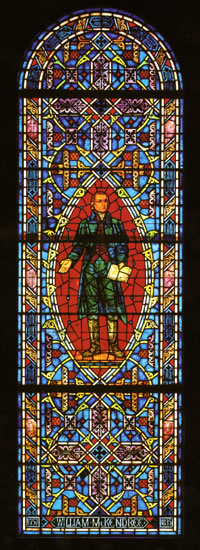
In 1787, he was converted because of a deep interest in the religious life. A remarkable speaker, he was received on trial in the conference in 1788 and remained active in the work of the ministry until 1792. That year, because of his support of others who attempted to reform the general conference, he sent in his resignation as a minister. The conference permitted him to continue preaching.
McKendree obtained leave from his preaching ministry to travel with Bishop Asbury. He did this for the purpose of finding out for himself whether his support of conference reformers had been correct, and he was convinced after only a short time that he had been deceived. He applied himself to careful study of the rules and discipline of the church and became convinced of its harmony with the early Christian church and its particular adaptability to the conditions of America.
In 1796, he became a presiding elder. In 1801, he was sent west to supervise the societies in Ohio, Kentucky, Tennessee, West Virginia, and part of Illinois. Because of his faithful attention to each aspect of his work, he became widely known and was highly esteemed. In 1808, he was elected to the office of bishop and from that time traveled to each ministry of the church. He was careful with the administration of the discipline among the societies and is regarded as the “Father of Western Methodism,” as well as a great preacher.
The left side border symbols of the McKendree window, numbered from top to bottom, are: 1. an Eastern cross with an upper bar above the usual crossbar of a Roman cross representing the trilingual superscription placed on the cross of Christ by order of Pontius Pilate, indicating he was “Jesus of Nazareth, King of the Jews.” At the bottom of the cross, the slanting bar called the “footrest” has a number of interpretations, most likely a reference to St. Andrew as the first Christian missionary in Russia. The Eastern or Slavic Cross often is used on the spires of the Eastern Orthodox churches; 2. the symbol of St. Matthew, with wings symbolic of service, representing the missionary activities of St. Matthew; and 3. the shield of St. Jude, with a cross on the sail of its ship , representing the missionary journeys of Jude, also known as Thaddaeus, who went to Syria, Arabia, and Mesopotamia preaching the Gospel.
The right side border symbols of the McKendree window, numbered from top to bottom, are: 1. the symbol of the Pentecost, with a dove and lamps representing the Holy Spirit and the Chi Rho representing Christ, symbolizing the spirit of Christ coming upon the disciples at Pentecost; 2. the lion of St. Mark, one of the traditional symbols for the writer of the second Gospel; and 3. the Chalice of Antioch representing a cup discovered in 1910. It was surmised that the chalice’s inner cup was used in the Last Supper.














